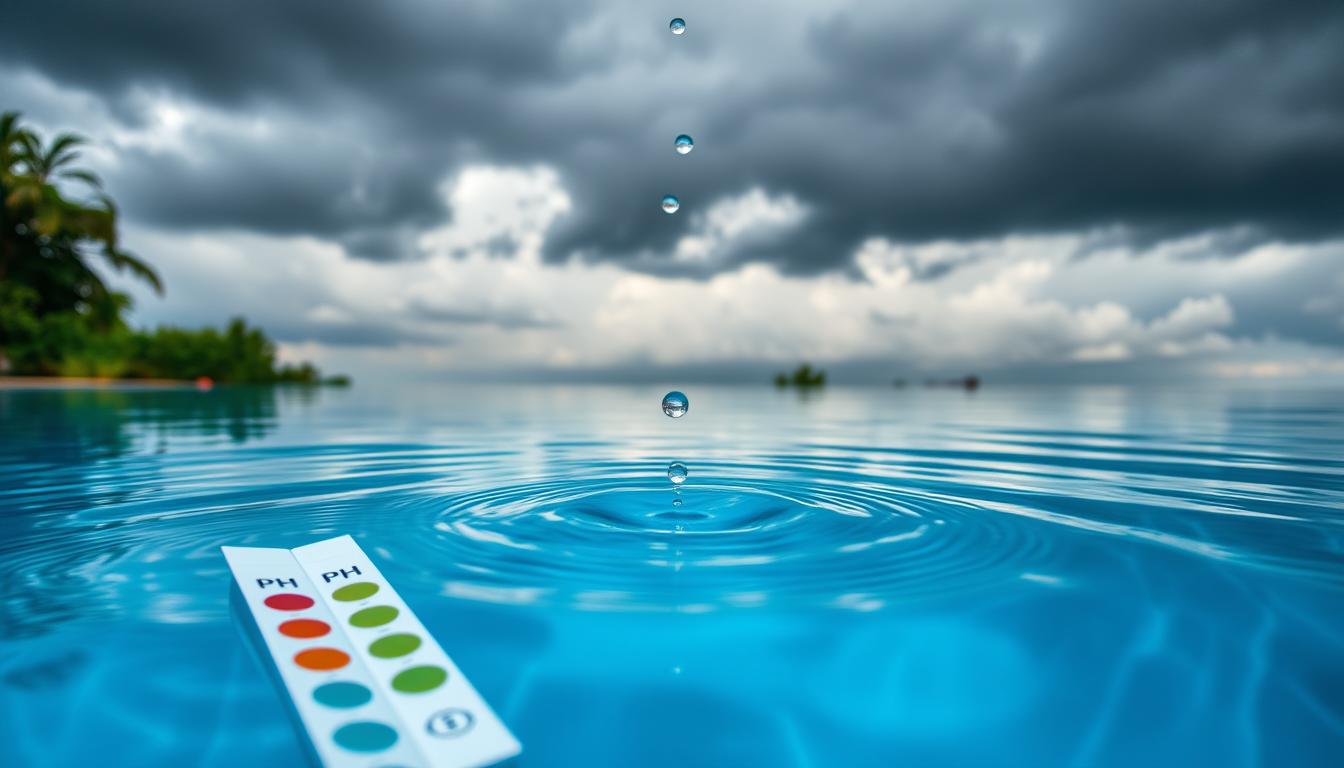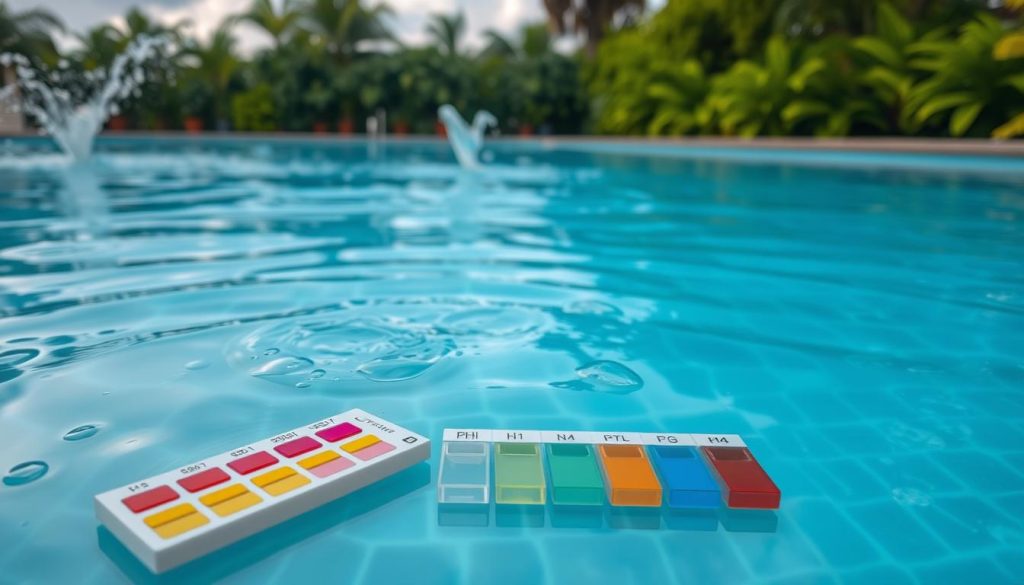
The average pH of rainwater in the U.S. is 5.0. This is lower than the ideal pool pH of 7.2 to 7.8. Heavy rainfall can greatly affect your pool’s pH balance and chemistry.
Understanding how rain impacts your pool’s acid-base balance is vital. It helps maintain a safe and comfortable swimming environment for everyone.
Rainwater can dilute pool chemicals, making them less effective. This can lower pH levels, total alkalinity, calcium hardness, and chlorine concentration. Heavy rainfall can dilute chemical levels by 5-10 ppm daily.
Rain brings more than just pH changes. It can introduce contaminants like dust, dirt, and spores into the water. These can lead to algae and bacteria growth.
To prevent issues, take action after a storm. Run your filtration system and add algaecide. Monitor and adjust your pool’s chemistry regularly.
By understanding rain’s effects and maintaining proper balance, your pool stays safe. It will remain an enjoyable oasis for you and your family.
How Rainfall Affects Pool Water Chemistry
Rain can drastically change pool water chemistry. It alters pH, total alkalinity, and chemical levels. Understanding these effects is key for proper pool care.

Rainwater’s Journey and Composition
Rainwater absorbs gases and pollutants as it falls. Pure rain has a neutral pH of 7.0. But it can become acidic with a pH of 5.5-6.5.
Rain also picks up spores, dust, and other contaminants. These additions further change pool water chemistry.
pH and Total Alkalinity Changes
Rainwater raises pool pH levels and lowers total alkalinity. Higher pH makes chlorine less effective. Lower alkalinity lets pH rise faster.
Rainwater has near-zero alkalinity. Heavy rains can reduce pool alkalinity by 5-10 ppm daily.
Heavy rains over a few days can significantly affect pool pH levels, potentially requiring pH Increaser for correction.
Dilution of Pool Chemicals
Rain dilutes pool chemistry levels. It lowers pH, alkalinity, hardness, stabilizer, and chlorine. Soft rainwater can decrease calcium hardness in pools.
In salt pools, heavy rains may dilute salt content. Extra salt may be needed to maintain proper levels.
| Pool Chemical | Ideal Range | Effect of Rainwater |
|---|---|---|
| pH | 7.2–7.6 | Dilution, causing pH to rise |
| Total Alkalinity | 80–120 ppm | Dilution, decreasing by 5–10 ppm per day |
| Calcium Hardness | 200–400 ppm | Dilution, especially if pool water is already soft |
| Cyanuric Acid (Stabilizer) | 20–50 ppm | Dilution, decreasing during heavy rainstorms |
| Chlorine | 1–3 ppm | Dilution, lowering effectiveness |
After rainfall, maintain proper pool water chemistry by:
- Clean the pool of visible debris and run the pump to filter out finer particles
- Check water levels and drain or vacuum out excess water along with settled debris
- Balance water chemistry by checking and adjusting pH, alkalinity, and chlorine levels
- Consider shocking the pool to sanitize the water, depending on the amount of rainfall and post-rain chlorine levels
Understanding rainfall’s effects on pool chemistry is crucial. Taking the right steps ensures a safe and fun swimming experience all season long.
does rain raise ph in pool
Rainfall can greatly affect pool water chemistry, especially pH levels. In North America, rainwater is acidic with a pH of 5.5-6.5. This can upset pool water’s pH balance and alkalinity level.
Acidic rainwater entering the pool can make pH levels rise. This can cause problems for swimmer comfort and pool equipment.
The Importance of Maintaining Proper pH Levels
Keeping a pool’s pH between 7.2 and 7.8 is vital. This range matches the human body’s pH. It ensures swimmer comfort and chlorine effectiveness.
If pH levels go outside this range, swimmers may feel eye and skin irritation. Higher pH levels also reduce chlorine’s ability to kill germs.
“Keeping your pool’s pH levels within the recommended range of 7.2 to 7.8 is vital for maintaining a safe and comfortable swimming environment for your family and friends.”
Here are some key points to remember about the importance of maintaining proper pH levels in your pool:
- A pH range of 7.2 to 7.8 ensures optimal swimmer comfort and prevents eye and skin irritation
- Proper pH levels enhance chlorine effectiveness, ensuring that the sanitizer can effectively kill germs and bacteria
- Maintaining the correct pH balance helps prevent corrosion and damage to pool surfaces and equipment
Potential Damage to Pool Surfaces and Equipment
Low alkalinity and pH in pools can create a corrosive water environment. This can harm underwater metal surfaces like lights, ladders, and rails.
Corrosive water can also damage pool equipment like heaters, pumps, and filters. It may etch masonry surfaces and wrinkle vinyl liners.
Corroded metal parts can release into the water. This may lead to staining and discoloration of pool surfaces.
| Pool Component | Potential Damage from Corrosive Water |
|---|---|
| Underwater metal surfaces (lights, ladders, rails) | Corrosion and deterioration |
| Pool equipment (heaters, pumps, filters) | Damage due to exposure to corrosive water |
| Masonry pool surfaces | Etching and erosion |
| Vinyl liners | Wrinkles and premature aging |
To protect your pool, monitor pH and alkalinity levels often. This is especially important during heavy rainfall periods.
Conclusion
Heavy rainfall can greatly affect pool water chemistry. It dilutes essential chemicals and introduces contaminants. Pool owners should monitor water chemistry after rainfall and adjust levels as needed.
Running the filtration system longer during and after heavy rains helps remove debris. It also prevents algae growth, a common issue caused by rainwater. Adding algaecide weekly can further prevent algae blooms.
A consistent pool maintenance routine is crucial for top condition. Regular testing and balancing of water chemistry are important. Proper circulation, filtration, and cleaning help tackle challenges from rainfall and other factors.
With extra care, you can enjoy a clean, inviting pool all season. Your pool will remain safe and comfortable for everyone, regardless of the weather.







